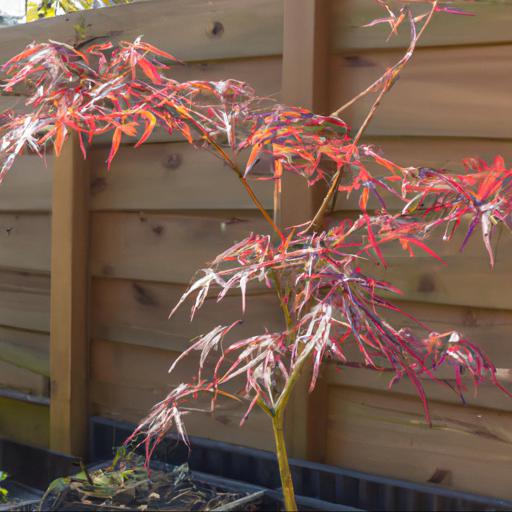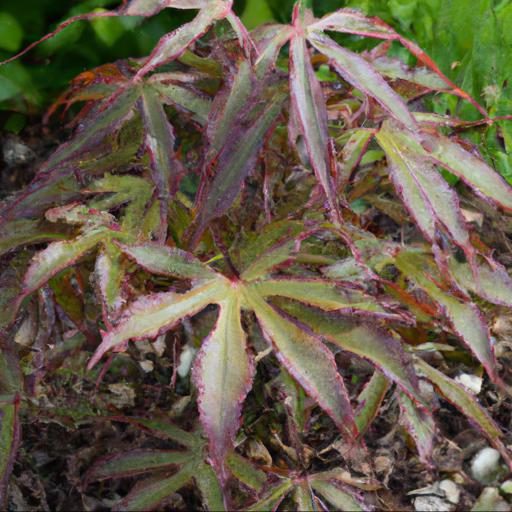Acer palmatum var. dissectum, commonly known as the Japanese Maple, is a stunning deciduous tree that is widely grown for its beautiful foliage. It is an excellent choice for small gardens, as it can reach a maximum height of around 6 metres.
The leaves are deeply divided into narrow lobes, giving them a delicate and graceful appearance. In spring, the leaves emerge with a vibrant red hue, gradually changing to a rich green in summer.
In autumn, the foliage turns to a magnificent array of reds, oranges and yellows, making it a truly eye-catching addition to any garden.
Benefits of growing acer palmatum var. dissectum

Acer palmatum var. dissectum, commonly known as the dissected Japanese Maple, is a popular choice for landscape and garden design in the UK. It is an ornamental deciduous tree that creates year-round interest with its stunning foliage and graceful form.
With the right care and attention you can easily reach the pinnacle of beauty with this species. The most obvious benefit of growing Acer palmatum var.
dissectum is its beauty. Its foliage is divided into slender lobes, giving them a delicate and elegant appearance. In the spring, the tips of each lobe are a vibrant green while the edges turn red, providing lovely contrasting foliage.
During summer, the foliage deepens to a deeper ruby red. Finally, in autumn, the leaves become fiery shades of yellow, orange, and red.
This remarkable colour palette makes it a show-stopping addition to any garden!Beyond its stunning aesthetic, this species also provides many practical benefits.
For instance, it prefers partial shade, making it ideal for areas away from direct sunlight. It is also relatively low maintenance with regards to pruning and watering, making it a great choice for novice gardeners. Furthermore, it is known to be suitable for a variety of soil types, so you won’t have to worry about specific soil requirements.
All in all, Acer palmatum var. dissectum is a stunning addition to any UK garden. With its colourful foliage, low maintenance needs, and ability to attract bees and birds, it is the perfect choice for anyone looking for a beautiful and practical addition to their outdoor space.
Tips for planting and caring for acer palmatum var. dissectum

. As one of the UK’s leading gardening experts, I can tell you that Acer palmatum var. dissectum, commonly known as the Japanese maple, is an absolutely stunning tree.
It can be used in a variety of different ways to add visual dimension and spectacular color to any landscape. The lush, cascading foliage and ornate shape of this tree, along with its growth rate of up to 30 cm (1 foot) annually, make it a popular choice for home gardens.
With a bit of know-how, you can easily create a breathtaking display full of vibrant foliage and eye-catching structure in your landscape. When planting and caring for an Acer palmatum var.
dissectum tree, the first step is to find a location in your garden that will receive ample sunshine and air circulation. The tree will flourish in well-drained soil, but it is also surprisingly resilient, and can handle more damp conditions than other species. To keep it looking its best, it should be regularly pruned to maintain its desired shape and size, while dead or overgrown branches should be selectively removed.
Having proper support, such as stakes, can also help the tree strong and healthy in the face of strong winds and snow. It is also important to ensure that your Acer palmatum var.
dissectum tree is regularly watered and mulched. Light, infrequent watering is best, as too much water can lead to root rot. Add a thick layer of mulch to help keep the soil cool and retain moisture.
Fertilizing your tree every spring will help replenish nutrients in the soil and encourage healthy growth. During the growing season, regular applications of a balanced, slow-release fertilizer can help promote lush foliage. Caring for an Acer palmatum var. dissectum tree does require some effort and dedication, but with the right amount of sunlight, water and proper care, it can offer years of beauty in your garden. If you follow the proper planting and care techniques, you can enjoy a gorgeous, ornamental showpiece in your landscape for many years to come.
Common diseases and pests of acer palmatum var. dissectum

As a UK garden expert, I would like to talk about the common diseases and pests of Acer palmatum var. Dissectum. This is a medium-sized deciduous shrub or small tree that can produce a compact and beautiful structure.
As it ages, its vibrant red autumn foliage is something to behold. It is a notoriously resilient species that is usually undemanding in terms of soil and water.
However, there are a few disease and pests that can infect this species; these include leaf spot, aphids and scale insects. Leaf spot is a common fungal disease of Acer palmatum var.
Dissectum and affects the foliage of affected plants. Symptoms of the disease include distinct spots in various shades of brown. These spots can distort the foliage and create thinned and discolored leaves.
To help prevent this disease, it is important to monitor the foliage of this plant and remove any infected or damaged leaves. Aphids are small, sucking insects that can cause stunted growth and honeydew deposits. Honeydewis a sticky, sugary secretion that will drip down the leaves of affected plants.
To control aphids, insecticidal soap can be used to help reduce their numbers. Scale insects are small, round insects that can cause yellowing of leaves, as well as leaf damage.
They are usually found on the underside of the leaves, where they feed on the plant’s sap. Insecticidal soap can also be used to control scale insects. If you find any of these diseases or pests affecting your Acer palmatum var. Dissectum, it is important to take swift action to ensure that the plant remains healthy. Removing any affected foliage, monitoring the plant and using insecticidal soap where necessary can help to keep your Acer palmatum var. Dissectum springing back to life in no time.
Our video recommendation
Conclusion
Acer palmatum var. dissectum, commonly known as Japanese Maple, is an ornamental tree with delicate, deeply lobed leaves and a graceful, weeping form.
It is an ideal choice for a small garden, as it grows slowly and can be kept pruned to a manageable size. It is also an excellent choice for bonsai and container gardens, as it responds well to pruning and shaping. It is an attractive tree with its graceful shape and vibrant autumn foliage.
FAQ
What are the characteristics of Acer palmatum var. dissectum?
Acer palmatum var. dissectum is a deciduous shrub or small tree with deeply divided, finely cut leaves. It has a mounding habit and typically grows to 6-10′ tall. Its foliage is a bright green in the summer, turning to shades of yellow, orange, and red in the fall. It is a slow-growing plant and is often used as an ornamental in gardens.
How does Acer palmatum var. dissectum differ from other varieties of Acer palmatum?
Acer palmatum var. dissectum is a variety of Japanese maple that is distinguished from other varieties of Acer palmatum by its deeply cut, finely divided leaves, which give it a delicate, lacy appearance. It is also known for its vibrant autumn foliage, which ranges from yellow to orange to red.
What is the ideal climate for growing Acer palmatum var. dissectum?
The ideal climate for growing Acer palmatum var. dissectum is one with mild winters and cool summers, with temperatures ranging from -10 to 25 degrees Celsius. It prefers partial shade and moist, well-drained soil.
What are the common diseases and pests that affect Acer palmatum var. dissectum?
Common diseases and pests that affect Acer palmatum var. dissectum include powdery mildew, leaf spot, aphids, scale insects, and caterpillars.
How often should Acer palmatum var. dissectum be watered?
Acer palmatum var. dissectum should be watered regularly, about once or twice a week, depending on the season and the soil moisture.
What are the best pruning techniques for Acer palmatum var. dissectum?
The best pruning techniques for Acer palmatum var. dissectum are thinning, heading, and pinching. Thinning involves removing entire branches to open up the canopy and allow more light and air to reach the inner branches. Heading involves cutting back branches to a bud or lateral branch to reduce the overall size of the tree. Pinching involves removing the tips of branches to encourage bushier growth.

